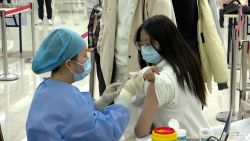Editor’s Note: A version of this story appeared in CNN’s Meanwhile in China newsletter, a three-times-a-week update exploring what you need to know about the country’s rise and how it impacts the world. Sign up here.
As the world grapples with the new Omicron coronavirus variant, China is determined as ever to eliminate Covid-19 within its borders – but it hasn’t been able to achieve that ambitious goal for the past seven weeks.
Since October 17, China has reported at least one locally transmitted case everyday, as local outbreaks continue to flare up one after another with increasingly short intermissions.
While its caseload pales in comparison with those of many countries – including the United States, which is averaging more than 100,000 new cases a day – the unceasing flareups underscore the growing challenge China faces to keep infections at zero.
For more than a year, China has been highly efficient in curbing local outbreaks with mass testing, snap lockdowns, vigilant surveillance and extensive quarantines – all the while keeping the border tightly sealed.
As proof of the success of these measures, not a single Covid-related death has been reported in the country since late January.
More recently, however, authorities have resorted to ever more stringent measures, quarantining not only residents who have been in direct contact with an infected person, but also secondary contacts and people who happen to be in the same general area at about the same time.
In the past seven weeks, nearly 10,000 tourists were trapped in Inner Mongolia for a week after a lockdown was imposed over dozens of cases; Shanghai Disneyland was shut down over a single confirmed case known to have visited the park; high-speed trains were stopped midway through their journeys to Beijing when close contacts of confirmed cases were found among crew members; and some local Covid prevention workers even killed pets during home disinfection while their owners were away in quarantine.
These strict measures eventually succeeded in bringing infections in those specific localities down to zero – but not for long.
Over the past week, more than 300 cases have been reported in Inner Mongolia, this time in Manzhouli, a crucial port of entry bordering Russia. The local government imposed a snap lockdown, and the city is currently rolling out a 9th round of mass testing for its more than 150,000 residents – but that still isn’t quick enough in the eyes of higher authorities.
Over the weekend, the city fired two officials for their “slow and weak response” to the outbreak – one for delaying the transfer and quarantine of more than 100 close contacts, and the other for his poor management of quarantine hotels, state media reported. Another four officials were criticized for their lackluster performances.
Local officials across China have been fired or punished for failing to contain Covid flare-ups. The goal to keep infections at zero has placed tremendous pressure on local authorities – often sending them into overdrive in imposing unnecessarily draconian measures, sometimes at the disproportionate expense of disruption of daily lives.
While mainstream Chinese public opinion still appears to support the government’s zero-Covid policy, excessive local measures have sparked discontent and criticism in some regions, such as the southwestern border town of Ruili and the Ili prefecture in Xinjiang.
In addition to Inner Mongolia, cases have been detected over the past week in the country’s largest cities, from Beijing and Shanghai to Guangzhou. The provinces of Heilongjiang, Shaanxi, Hebei and Yunnan also reported cases.
China remains one of the last countries attempting to maintain zero-Covid, as the rest of the world learns to live with the virus. But the arrival of the Omicron variant has sent nations in a scramble to impose travel restrictions – and if anything only strengthened China’s intent to keep its borders tightly sealed. (So far China has yet to detect Omicron.)
A recent study by mathematicians at the country’s prestigious Peking University has found that China could face more than 630,000 Covid-19 infections a day if it dropped its zero-tolerance policies by lifting travel curbs – which would “almost certainly induce an unaffordable burden on the medical system,” the report said.
It concluded that China should not give up zero-Covid for the time being, until there are “more efficient vaccinations or more specific treatment, preferably the combination of both.”
Over the weekend, Zhong Nanshan, a top Chinese respiratory disease expert and government adviser, proposed two prerequisites for the lifting of the zero-tolerance approach: one is for the fatality rate of Covid-19 to drop to around 0.1%, and the other is for the basic reproduction number of Covid to drop between 1 and 1.5, meaning every infected person will spread the virus to an average of 1 to 1.5 people in a susceptible population.
In August, researchers who studied a Delta variant outbreak in Guangdong province estimated Delta’s basic reproduction number to be 6.4 – which is much higher than the coronavirus variant first detected in Wuhan. The World Health Organization says it is not yet clear whether the new Omicron variant is more transmissible than Delta.























